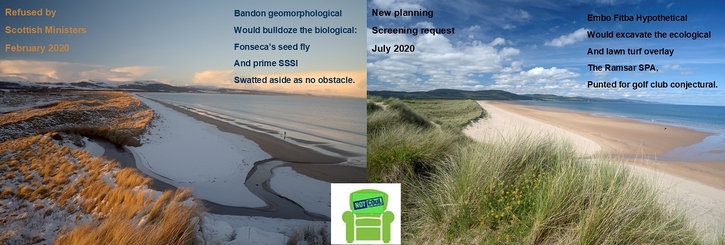A planning application was submitted to Highland Council to construct an 18-hole international golf course on Coul Links, Sutherland but the applicant is not Trump Golf. The target lies within Loch Fleet Site of Special Scientific Interest, Special Protection Area for birds & international Ramsar wetland, which is predominantly estuary. Coul Links is one of very few expanses of undeveloped & largely unspoilt sand dunes remaining in Scotland, & its special wildlife & landforms are protected by those UK & European legal designations & international treaty. Development would be at odds with Highland Council’s environmental policies.
The government’s conservation agency, which objected, describes SSSIs as “areas of land & water that Scottish Natural Heritage (SNH) considers to best represent our natural heritage - its diversity of plants, animals & habitats, rocks & landforms, or a combination of such natural features. They are the essential building blocks of Scotland's protected areas for nature conservation … It is an offence for any person to intentionally or recklessly damage the protected natural features of an SSSI."
Trump got official approval to destroy Foveran Links SSSI after exaggerating economic benefits, much shenanigans & Scottish Government intervention. That site will probably be denotified as SSSI (confirmed Dec 2020). The present speculator is Coul Links Ltd. led by Mike Keiser, President of Bandon Dunes Golf Resort, Oregon, Trump Golf’s main global rival, & entrepreneur Todd Warnock who similarly claims 'I can make this environment better'.
From Oct 2015, press articles publicised proposals for the golf course. Developers blithely spoke of perceived advantages to golf & economy, ignored conservation designations but mentioned new nature trails & wildlife ‘information’. Development propaganda has not informed the public what wildlife, habitat, landforms & amenity will be destroyed & degraded. Exhibitions in Aug 2016 & Oct 2017, to elicit public votes of support, paid scant attention to wildlife & presented flawed ecology. The former relegated a habitat survey to just a tiny cryptic map at Scottie dog eye level. The less truth people know the less insensitive the plans appear.
Golf course construction would be an unnatural catastrophe. It would mean excavating, recontouring, burying wet slacks, reseeding with introduced grasses, addition of plastic membranes, irrigating & intensively mowing 40.5 ha, habitat fragmentation, under-grazing & eradication of (valuable grazers & browsers) rabbits & deer, fertilising & herbiciding (& run-off), with substantial collateral damage, immediate & insidious, & bulk habitat & species translocation of 4.5 ha. dune heath, with insects & rare lichens, & 100 rare dune juniper, with displacements on receptor areas, contrary to government's 'A Habitats Translocation Policy for Britain' (2003) recently relaxed.
Size & connectivity of habitats are ecologically critical, affecting species populations, diversity, interaction & survivability. Construction traffic, borrow pits & sand-moving would disturb & damage the geomorphology, hydrology (water quality & seasonality), low-nutrient profiles (on which plants rely) & habitat biodiversity over a much wider area. Fine irregular patterns of topography, micro-habitats & vegetation mosaics, like dry hummocks & wet slacks, would be destroyed, displacing specialised, scarce, rare & vulnerable plants & insects. Human disturbance would reduce bird populations in surviving habitats.
Dunes naturally have cycles of erosion & deposition. Plans include greens & fairways constructed near foredune crests & a burn outlet, eliminating important species & weakening natural sea defences regardless of risks. This would probably necessitate adding a culvert & an artificial expanse of boulder rip rap, leading to beach narrowing (part National Nature Reserve) & coastal erosion nearby, the judgement of leading geomorphologist Dr Jim Hansom of Glasgow University.
Compromise from 'invasive' species, the result of management neglect & rejected SNH grant aid (£230,000 since 2010), & regenerating North American lodgepole pines (misidentified by golf's ecologists as Scots pines), is being grossly exaggerated to excuse 'remediating' so much natural vegetation with manicured mediocrity. Naturalness is a key criterion in SSSI selection. Bracken, gorse, tall herbs & rank grassland support more wildlife than lawns:
https://butterfly-conservation.org/files/habitat-bracken-for-butterflies.pdf. Fonseca's seed-fly, thought endemic to Sutherland dunes, requires 'weeds'. Claims about biodiversity net gain from moving fragile habitats & species, controlling Scots Pine, rare & native at Coul, & cessation of duck shooting are ludicrous.
Threatened habitats outside the SSSI, in a golf 'remediation' area, are of comparable biodiversity, including Fonseca's Seed-fly, Baltic Rush, Rough Horsetail, Moonwort, Skullcap, Butterwort, Fragrant, Frog & Creeping Lady's-tresses Orchids, Small Blue butterfly & plants at their northern UK limits, like Restharrow & abundant Rock-rose, the food-plant of scarce Northern Brown Argus butterfly.
The developers talk of 'sensitivity', 'minimalism', ‘naturalness’, 'utmost care' & the high repute of its designers, but Oregon track record conflicts:
https://oregoncoastalliance.org/bandon-dunesbiota-bulldoze-roads Leading dune ecologist Dr Tom Dargie describes the developer’s surveys & Environmental Statement as ‘unfit for purpose’. He judges the site worthy of (European) Special Area of Conservation (SAC) status, which would have prevented such development being considered.
There is a superfluity of coastal golf courses in Scotland, many undersubscribed, some closing, mostly eroding. The environmentally responsible option is to avoid development within such special, rare & fragile habitats.
.jpg)


